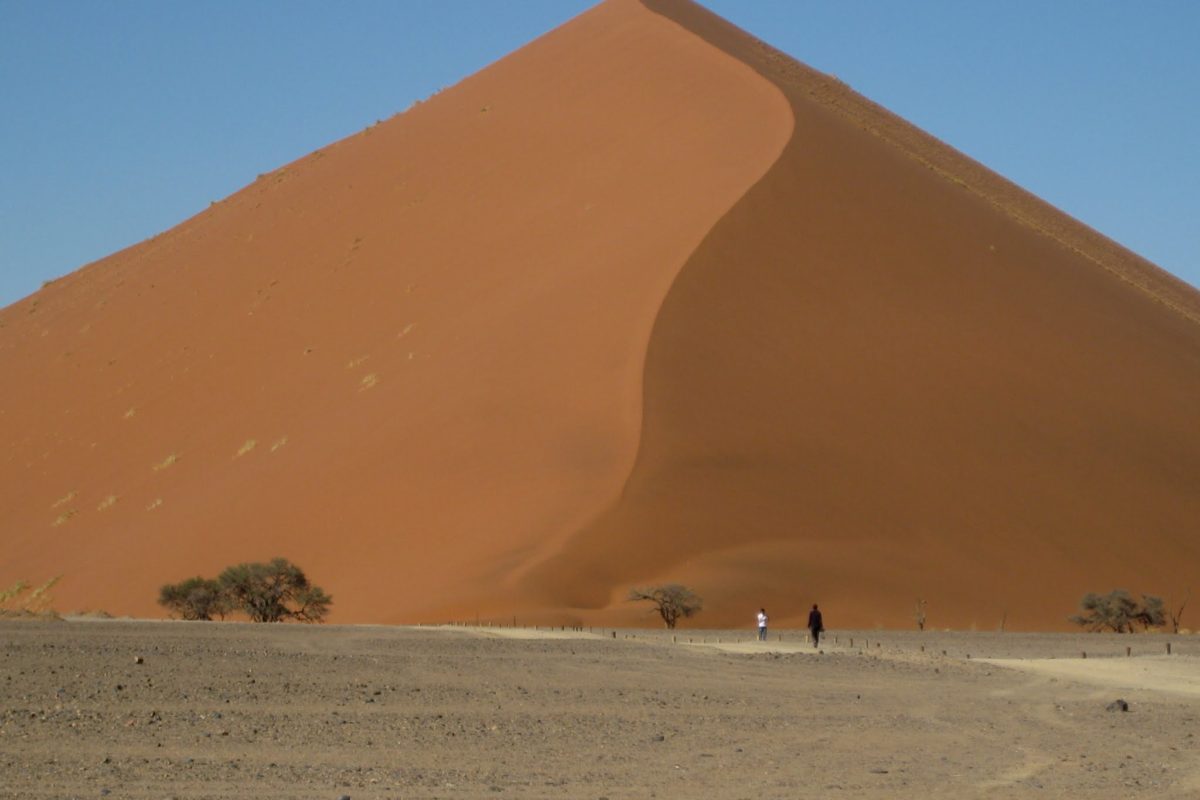
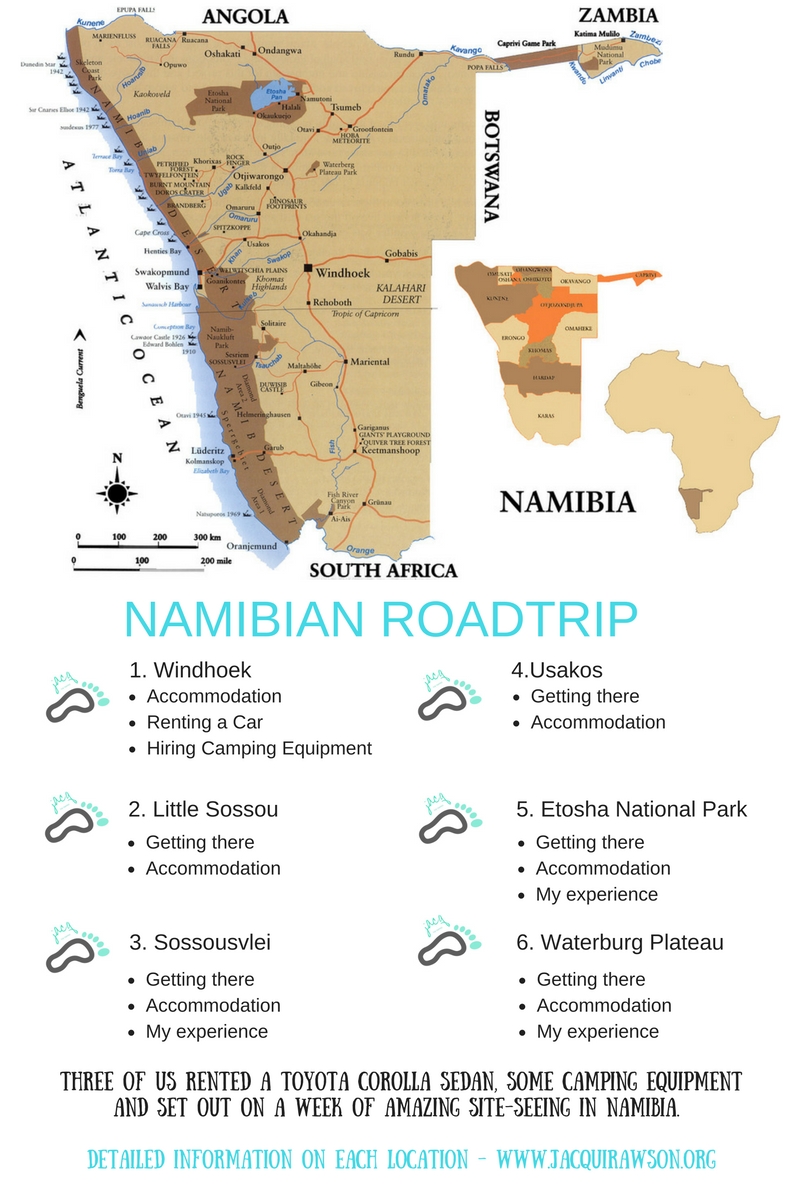 At the moment Namibia’s tourism industry is flourishing. There no longer seems to be a low season. The owner of one of the backpackers suggested it could be due to a couple of reasons; there are no extremist threats or bombings to worry about, the value of Namibia’s currency makes it a relatively cheap option for Africa at the moment plus it is just an amazing country to visit.
At the moment Namibia’s tourism industry is flourishing. There no longer seems to be a low season. The owner of one of the backpackers suggested it could be due to a couple of reasons; there are no extremist threats or bombings to worry about, the value of Namibia’s currency makes it a relatively cheap option for Africa at the moment plus it is just an amazing country to visit.
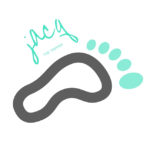 1.Windhoek
1.Windhoek
Accommodation
Chameleon Backpackers
- in my opinion the best by far of the options
- it gets very booked out, my advice is to try and book a couple of weeks ahead if you can
- spotlessly clean, very secure with keys issued for the front gate
- fairly small swimming pool
- lots of comfy hang-out areas including a tv-lounge area
- 5 minutes walk to the town centre
- a Safari bookings office on site
- very helpful, friendly staff
- safe family-feel environment
- inexpensive bar
- meal nights for $80 Monday to Saturday include pizza, braii’s etc
- the dorm I stayed in was on the small size and the ensuite was in the same room so not a lot of privacy
- laundry is $50 na ($3.30 usd) or there’s a tub where you can do your own, everything dries in no time due to the very dry air
- there are two resident dogs, Blackie and Woody
Paradise Gardens
- a house with a homely feel
- very clean thanks to the lovely cleaner, Goldie
- secure with a key pad, locked gate
- largish dorm rooms
- comfy beds with clean bedding including duvets
- a dog and a cat
- mini-mart 5 minutes walk away and the centre of town about 15-20 minutes walk
- there are lots of long term students staying here
- nice and quiet
CardBoard Box
- not very clean
- only one key for dorm rooms, so no locking but they do have lockers in the room – need own lock
- there’s a washing machine you can pay $15 ($1 usd) to use
- it’s falling apart in some areas but there are signs saying renovations are planned
- nice big pool and bar hangout area
- nice staff
- not very secure as the bar is open to the public and it’s wide open from there to the unlockable dorm rooms
- there are quite a few rumors of theft
- the beds are comfy and they have warm bedding
Hiring A Car
Back to my comment regarding a continuous high season, the 4×4’s get very booked out, so again, you probably need to book ahead of time although you might get lucky. They’re also quite expensive, more expensive than we could afford so we booked a “medium sized” car instead. It was a Toyota Corolla, manual, 1.6ltr and had enough room for three of us and our camping equipment. The only downside was we had to go slower on gravel roads which meant every 4×4 sped past us, leaving us with no visibility and coated in dust. We went through Thrifty Car Rentals and it was $4050 na ($290 usd) for 7 days with unlimited km’s. The petrol cost us $2040 na ($136 usd) and we chewed up 2,694 km’s.
Camping Equipment
We hired our equipment from Adventure Camping Equipment Hire. They have everything you could need, from tents to wooden spoons. We went fairly basic at $700 na ($46 usd) per person for the 7 days. This included a three-person tent, slim fold up mattresses, blankets, a gas cooker, chilly-bin (ice chest, esky, chiller box), a pot and wooden spoon. Sleeping bags were too expensive at $250 na ($16 usd) per day. It was cheaper to buy one but unfortunately, I couldn’t find one in the limited amount of time we had before heading out. And therefore froze each night with the blankets we’d hired.
Heading South From Windhoek
Buy a Namibia roadmap for about $20NA ($1.30 usd), have a good co-pilot and you should be able to get out of Windhoek town, onto the B1 and hitting the open road without too many hiccups. At 140 km/h the first 3 hours, along with the landscape flew by. 
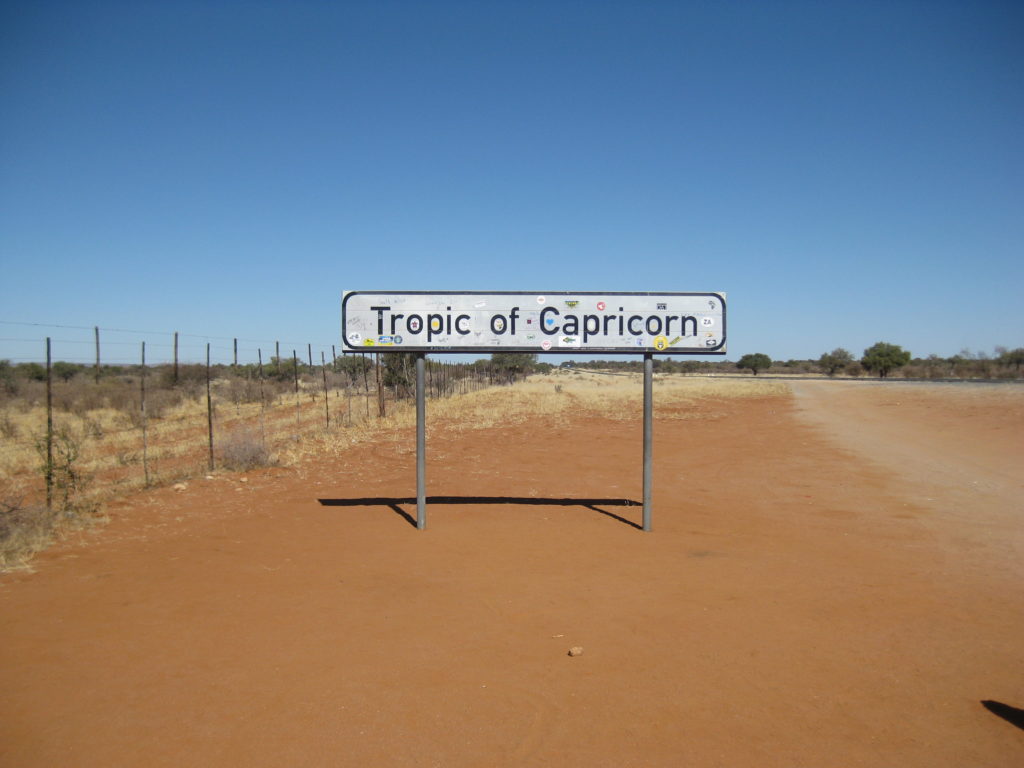 We passed the Tropic of Capricorn, a few trucks and a very dry, flat landscape that in itself is very different from anything I’d seen before. We’d managed to get away by midday and decided to stop for the night early’ish at a town called Maltahohe because it seemed fairly close to Sossusvlei. A big rookie mistake, as the lovely lady at the last camp site on the road out, told us. Because the road from there on was gravel, it was another 3 hours to Sesriem town. So we borrowed her toilet, bought some batteries, thanked her for her advice and hit the road again.
We passed the Tropic of Capricorn, a few trucks and a very dry, flat landscape that in itself is very different from anything I’d seen before. We’d managed to get away by midday and decided to stop for the night early’ish at a town called Maltahohe because it seemed fairly close to Sossusvlei. A big rookie mistake, as the lovely lady at the last camp site on the road out, told us. Because the road from there on was gravel, it was another 3 hours to Sesriem town. So we borrowed her toilet, bought some batteries, thanked her for her advice and hit the road again.
Slow Going
It was very slow progress at a max 60km/h but made for interesting driving as I used the whole road in an attempt to find the best spot. Which meant the spot with the least vibrations and damage to the undercarriage. In parts, it felt like a tank had rolled through and left a million narrow grids on the road. Although the road was shaky, the scenery was truly amazing! Now, instead of a flat, arid landscape, there were hills, plateaus, and deep valleys. And the road ahead, snaked around and in between them onwards towards the horizon that was so far into the distance it appeared like it would never end.
The Tsaris Pass
We went through the Tsaris mountains via the Tsaris Pass as dusk was beginning to set in. The combination of a setting sun, filtered through a hovering level of haze over a sensational landscape really was breathtaking. So much so, I was tempted to drive back through again in daylight to appreciate it again with a new lens.
 2.The Lovely Little Sossus Camp
2.The Lovely Little Sossus Camp
Accommodation
Our first night of erecting the tent was in the dark. I think that’s a reasonable excuse for why we made three attempts before getting it anywhere close enough to staying in a vertical position. There followed a scary gas cooker malfunction when we started to cook, including metre high flames. My reaction was to hide behind a concrete wall, luckily Cody was a whole lot braver than me and somehow managed to turn the switch off using a wooden spoon. 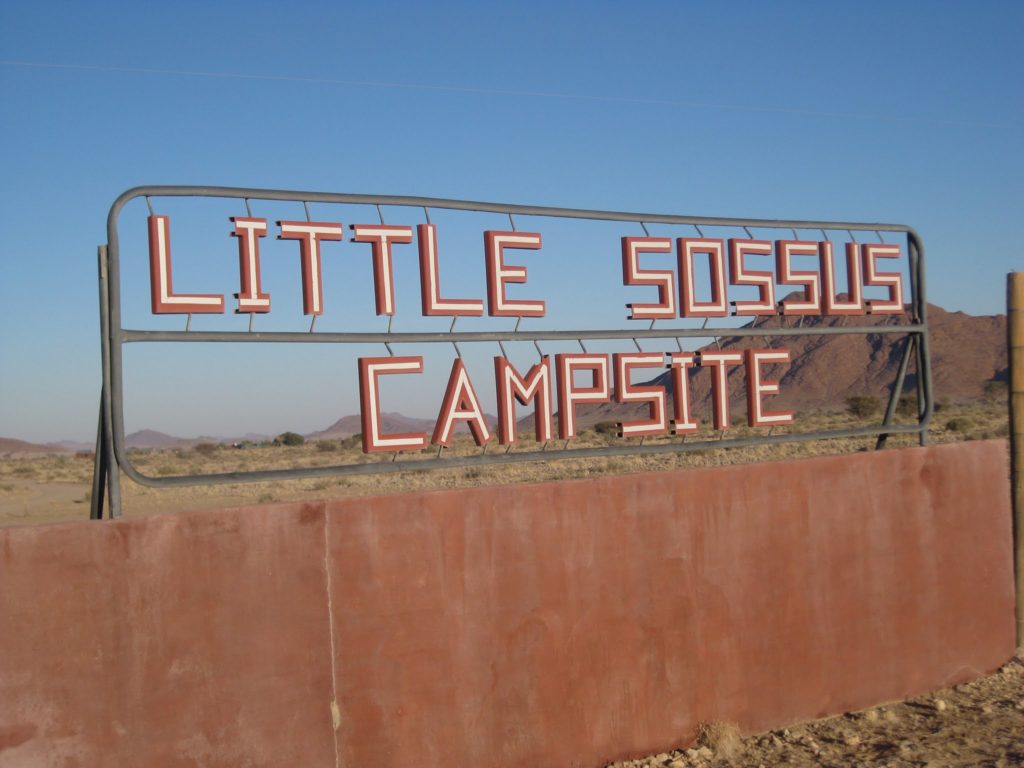
It was a lovely campsite for making you feel like you’re in the middle of a wilderness, desert wilderness. We actually pitched our tent on the top of hoof prints that looked like they belonged to a wildebeest or gemsbok.
We had our own bathroom, in fact, we had one bathroom on each side of the kitchen area. All of which were under the same roof where we parked the car and pitched the tent. Firewood was $40na ($2.6usd) and fire starters $20na ($1.30) and they provide a half barrel drum and grill to cook our boerewors (sausages) on.
 3.Sossusvlei
3.Sossusvlei
Getting There
It was roughly an hours gravel drive the next morning to Sossusvlei and we went straight to the petrol station to replace the 3/4’s of a tank of petrol we’d used. Then it was on towards the dunes inside the park, where it’s tarmac road and a 60 k/h speed limit. Like most people we headed straight to the furthest dune which was an hours drive past many other stunning burnt orange dunes, that one can never tire of taking photos of.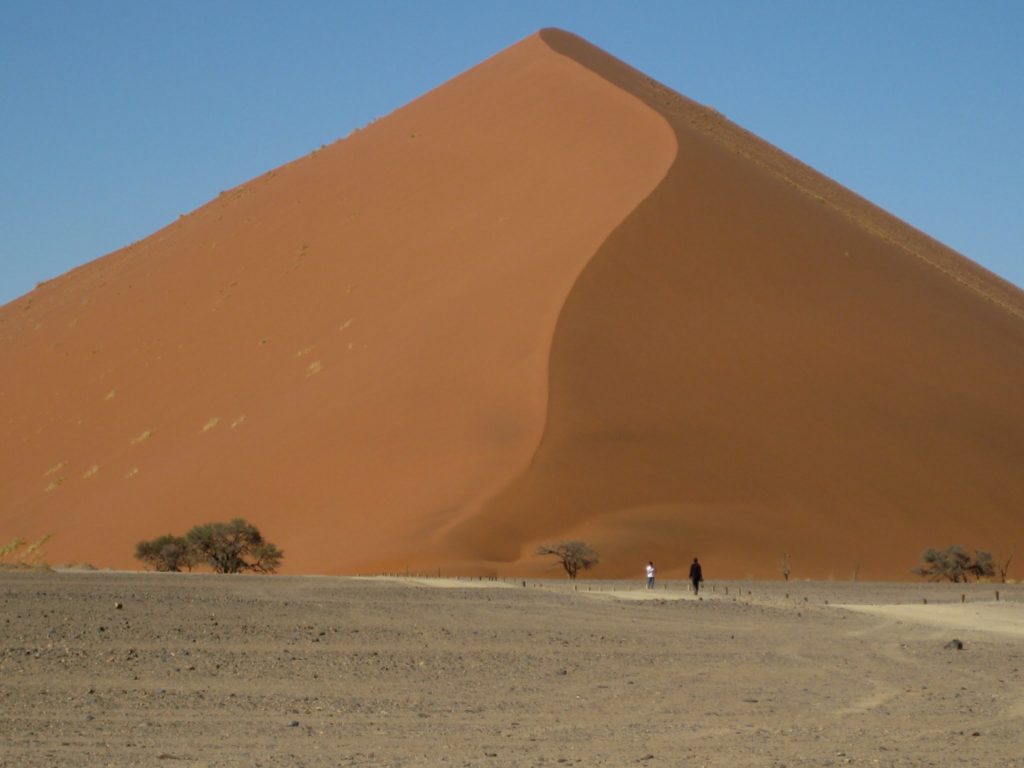
Gemsbok Spotting
The non-4×4 road ends and it’s still 5-6km to the dune but there are shuttles available for $60 na ($4 usd). We decided to walk to stretch our legs and save a bit of unnecessary expenditure. And we were so glad we did as we got to see our first Namibian wild animals up close in the form of this beautiful gemsbok (picture below) who sauntered past.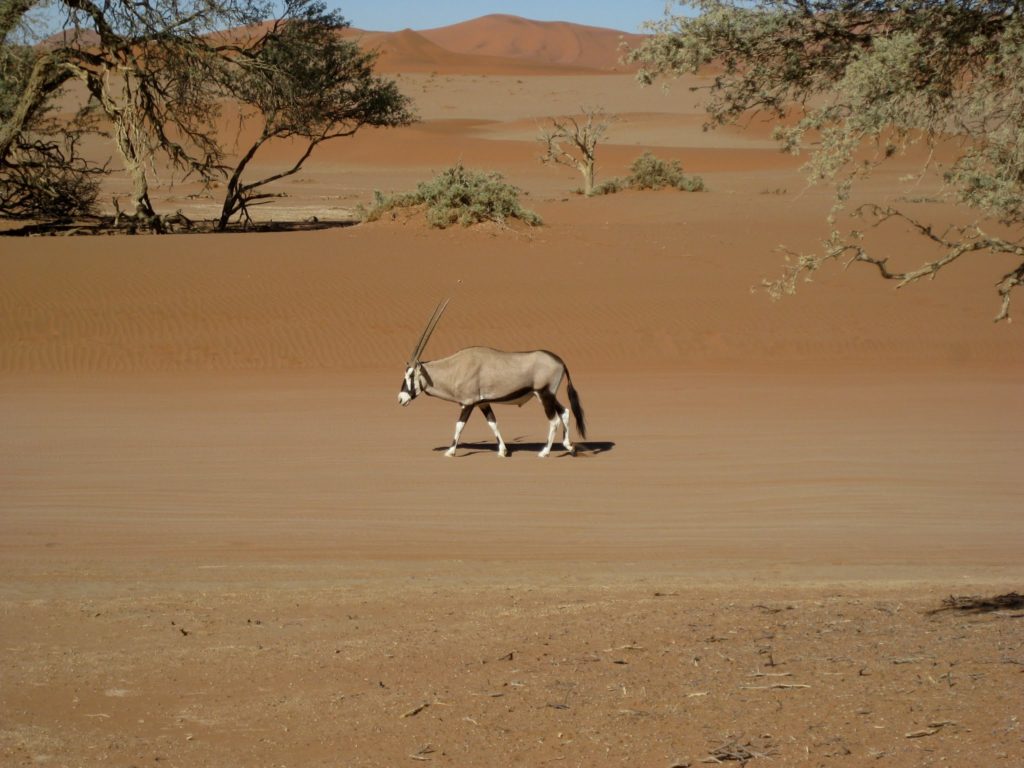
Climbing The Dune
We scurried like crabs up one side of the dune, lungs near to exploding and descended the same way not too much further along the ridge. We could see very brave or very crazy people, just specks in the far distance who had climbed to the highest point.
In my humble opinion, this place is stunning and really beyond any selection of adjectives I can throw together. Likewise any photos. This is one you really do need to see for yourself to appreciate it’s full amazingness.
The Pass Un-Passable
There is a pass called Sesriem Canyon within the park that is another tourist attraction but the road leading to it was so rutted that I gave up on our attempt to get there in our little wee car.
Accommodation
We stayed outside the park at the Sossus Oasis Camp Site which is close to the petrol station, mechanics garage, mini-mart and internet cafe. Again, the camp was lovely with individual cooking areas and amazing views of the desert landscape which included a full moon on our visit. The ablutions were open aired so you could shower while checking out the scenery or watching a place fly overhead all at the same time. There’s also an huge Weaver Birds nest in a tree within the campsite.
A MoonScape
There was more gravel road the next day, some of the worst yet, but there’s unfortunately, no other option. Most of the vehicles, including mini-vans, sped past us.
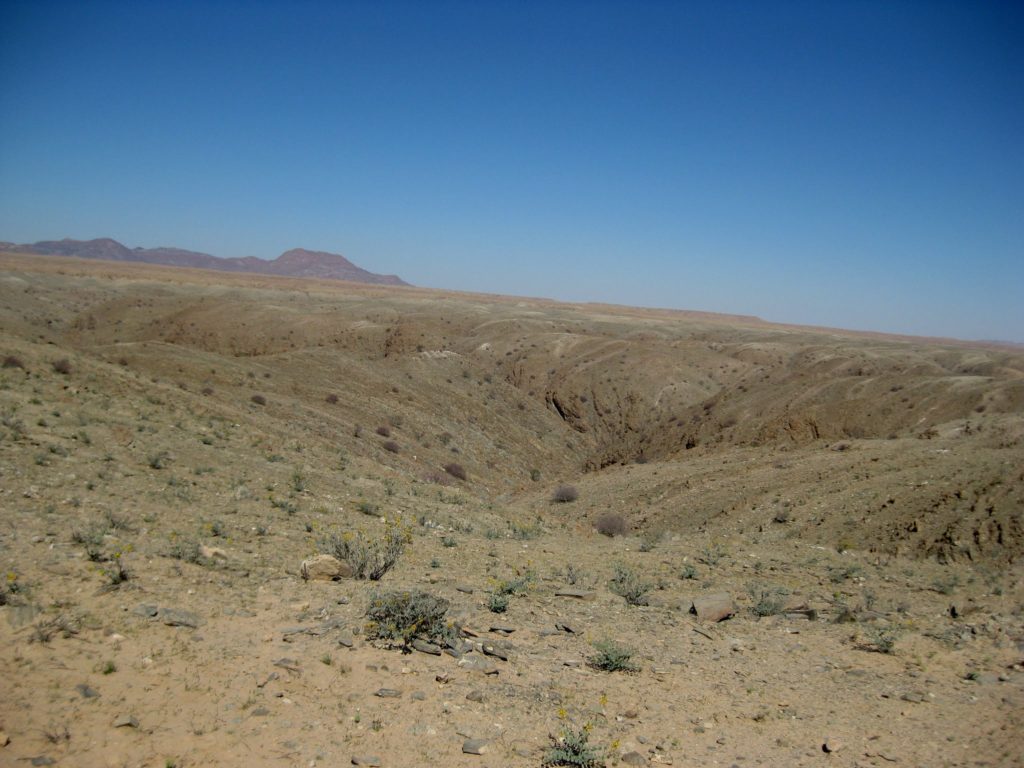 The scenery changed again as we came out of the plains and began to climb through very rocky gullies and mountain passes. It was fun driving into the corners and navigating bends. It reminded of driving at home although the landscape was once again like nothing I’d seen before.
The scenery changed again as we came out of the plains and began to climb through very rocky gullies and mountain passes. It was fun driving into the corners and navigating bends. It reminded of driving at home although the landscape was once again like nothing I’d seen before.
 4.Usukos
4.Usukos
Getting There
Enroute to Usukos is Walvis Bay, which is about 380km (and takes about 5 hours) from Sesriem. And is where I got to see the sea again for the first time in three weeks. There’s a lot of trucks and sand blowing across the road like a fine mist the closer you get to Walvis Bay.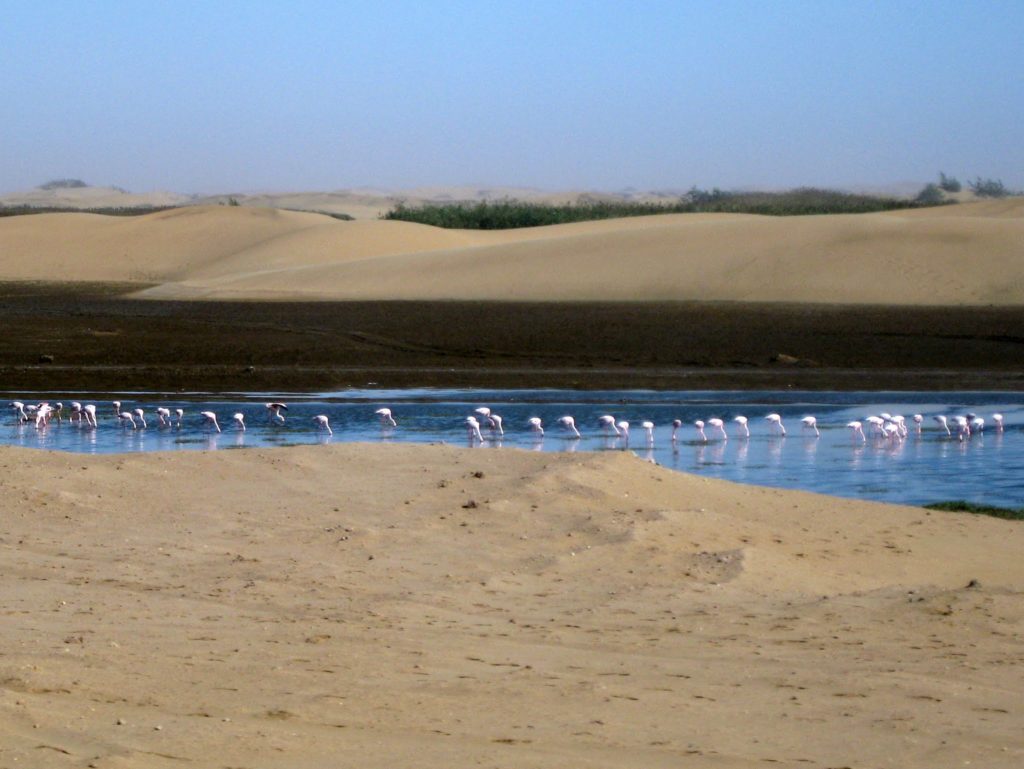
The flamingos and a glimpse of the sea were all we got to see of Walvis Bay, however, as we decided to push on through. The aim was to eat up as many miles as we could in order to bring us as close to Etosha Park as we could manage in daylight hours. Ready for getting there early the next day.
Accommodation
We made it to Usukos just at dusk and ended up staying at a self-catering place on the Etosha side of the town. It was a huge house, with kitchen, two bedrooms and strangely only one shower for $500 na ($33 usd) per night.
The Outjo Bakery – A Must Visit
I’d been told about a great bakery in Outjo so headed straight there for breakfast. It was a 300km distance away from Usuko but on straight, open roads with very little traffic, it took us what felt like very little time to get there. They have a choice of about 20 different homemade pies and pastries which included sausage rolls, all of which looked delicious. Add to that, cakes and strudels, red velvet cupcakes, cookies, and brownies – the scrumptious list goes on and includes great coffee.
NB. They are not open on Sunday’s which we discovered to my utter dismay on our return trip back through Outjo.
 5.Etosha National Park
5.Etosha National Park
Getting There
From Outjo to Andersons Gate, at the southern end of the Etosha National Park, it’s only a distance of 140km (1hr – 1.5hr) drive on the C38 tarmac road. Andersons is one of four gates where you need to provide your passport and car registration. You’re now officially in the park where the speed limit is 60 km/h, everywhere within the 20,000 square kms. In 1907 when it was first officially recognised as a National Park it was 100,000 square kms.
Accommodation
There are three camp sites in the park, the first of which seems to be the most popular, Okaukuejo. Next is Halali which is 75km from Okaukuejo and from there it’s another 75km to the last camp, Namutoni. All the camps have swimming pools and night-viewing watering holes for animal watching.
Cost
At the time of writing this (July 2016) it’s $209.33 na ($13.95 usd) p/p, p/night to camp with your own tent. On top of this, there is a $80 ($0.53 usd) p/p, p/day park fee and a $10 ($0.65 usd) for a car p/day park fee.
My Experience
At the first camp, Okaukuejo we picked up the MUST have park map for $40 na ($2.66 usd). It provides distances between watering holes, campsites and it also lists all the animals known to be in the park. Including pictures of them, their hoove prints and what their poo looks like.
There was a definite sense of excitement in the car in anticipation of what animal sighting might be ahead. For me, what actually came to pass was so much more exhilarating than anything I could have ever anticipated.
The park covers 23,000 sqm’s of arid open plains interspersed with bushy, tree covered areas and numerous watering holes. Whereas, a few days before we’d gotten excited about seeing our first gemsbok, within 15 minutes of driving they had become passe as they were everywhere along with the multitudes of other species of these antelopes-types. Which include; Kudu’s, Oryx, Springboks, Waterbucks, Gemsboks and Impalas to name a few. And although all are stunningly graceful and refinded your mind naturally begins to seek things less seen.
Which didn’t take long because on reaching the first watering hole it was hard to know where to look first. There was a menagerie of animals drinking, walking, fighting and watching. The stand out were the gangly giraffes, farily easy to spot in this particualr open exspanse. We were heading towards Halali, our camp site for the night and tried to call into as many watering holes as we could on the way.
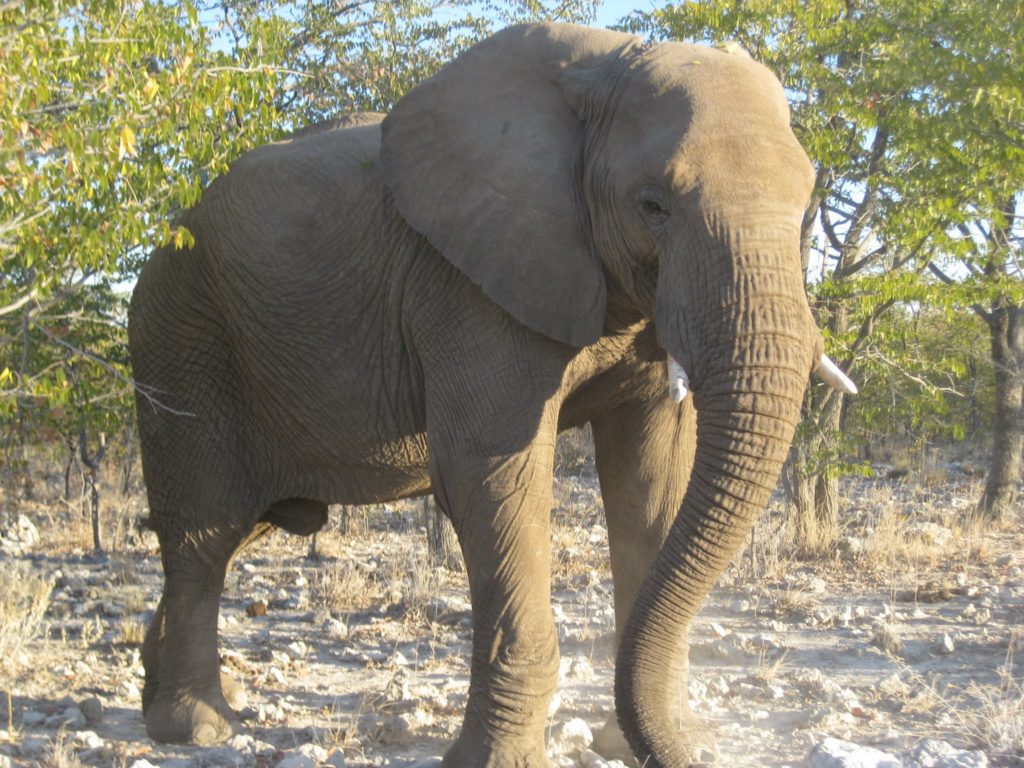
Our second delight was a lone bull elephant in amongst some trees that I’d seen in a flash as we drove past. We turned around, went back and managed to watch him for ages as he ate and tramped amongst the bush only 2 metres from the car. We couldn’t understand why nobody was as impressed as we were, stopping to take photos too. Later we came to realise just how much it was actually possible to see.
The sun was beginning to sink and it made not only for beautiful photo lighting but it also meant the animals were becoming active. Next, we got to see a black rhino disappearing off into the scrub as well as wildebeest, lots more giraffes, ostriches, springboks etc, etc.
We hit camp around 4.30pm, pitched the tent, cooked some dinner over the braai pit provided to each camp site and then headed to the camps floodlit watering hole. I was semi-rugged up, leggings, jersey, scarf, beanie, socks and shoes. It gets bleeding cold here in the desert.
Three guys heading away from the watering hole told they’d just seen three rhinos. I would have stayed all night at the watering hole if it wasn’t as cold as it was because it was AMAZING. It was almost like it had been scripted, a broadway play with the watering hole centre stage. Behind the reach of the flood lights were the stage’s wings and back stage area.
Better Than A BroadWay Show
The rhinos drank, then two of them tussled horns for drinking space. Eventually, they exited, stage left, off into the scrub and beyond the light. There was a mini interval break and then the elephants entered, again from stage left. A few at a time entered until we had a whole herd of about 13 elephants drinking at the hole. A couple of the bulls didn’t drink but stood on sentry duty instead. One of them trumpeting and flapping his huge ears at a rhino that had wandered back for a drink. Superiority had been established and things settled down.
Some of the elephants while drinking would stand on three legs and kick the other leg out behind them. Stretching out one leg? Keeping circulation going? Freeing up space for more water? Your guess is as good as mine, but it was fun to watch. Hyenas also turned up between scenes but other than that, the show may have gone on but it did so without me as I was way too cold to stay and view it.
So impressed were we by the watering hole, we booked in for another night at Halali before we headed out the next morning. Around 10am, we had to pull-up en route to our first watering hole, called Nuamses because of elephants crossing the road.
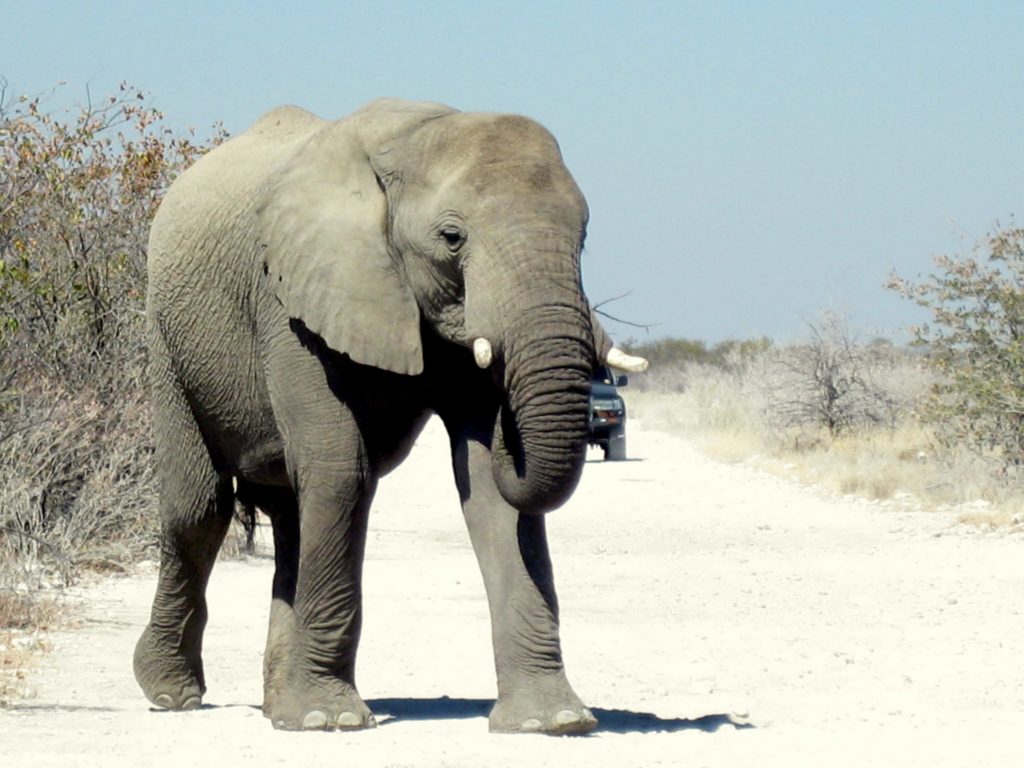
Now, I’ve seen elephants before in Asia, and yes I’ll admit I’ve even ridden a few. But Asian elephants are miniatures in comparison to these huge beauties! Africa seems to do everything on a much bigger scale, its elephants, mosquitos etc. These big boys strolling around our suddenly small, wee car seemed like they could quite easily plonk their very wrinkly arses on our bonnet and squash it into the ground.
More exciting than this, though, was the realisation that the elephants were heading the same place as us. We rocked up to the watering hole, once the elephants had allowed us to pass, and found a good spot to park up as some 4×4’s were leaving. We didn’t have to wait long for the elephants to start rocking up too. And they kept coming and coming! In total, there ended up being about 50 elephants which I’m guessing were mixed herds as the bulls did a fair bit of tussling and trumpeting to show dominance and fight for drinking space.
The whole watering hole ended up surrounded by elephants of different gender, ages, and sizes. Drinking, swimming, playing, tussling, attempting to mate, throwing dirt over their wet bodies and standing guard were what made up the watering hole activities that day. I have no idea how long we stayed but what a sight to behold, what an experience to have. We only left once the majority of elephants had left too.
The only way to beat that for me was to see some lions which we did a bit later that day. A car on the road ahead of us had stopped, a clear indication that some type of animal was around. And there they were, two lionesses and a lion lying in the shade of a tree about 4 metres from us, parked on the road.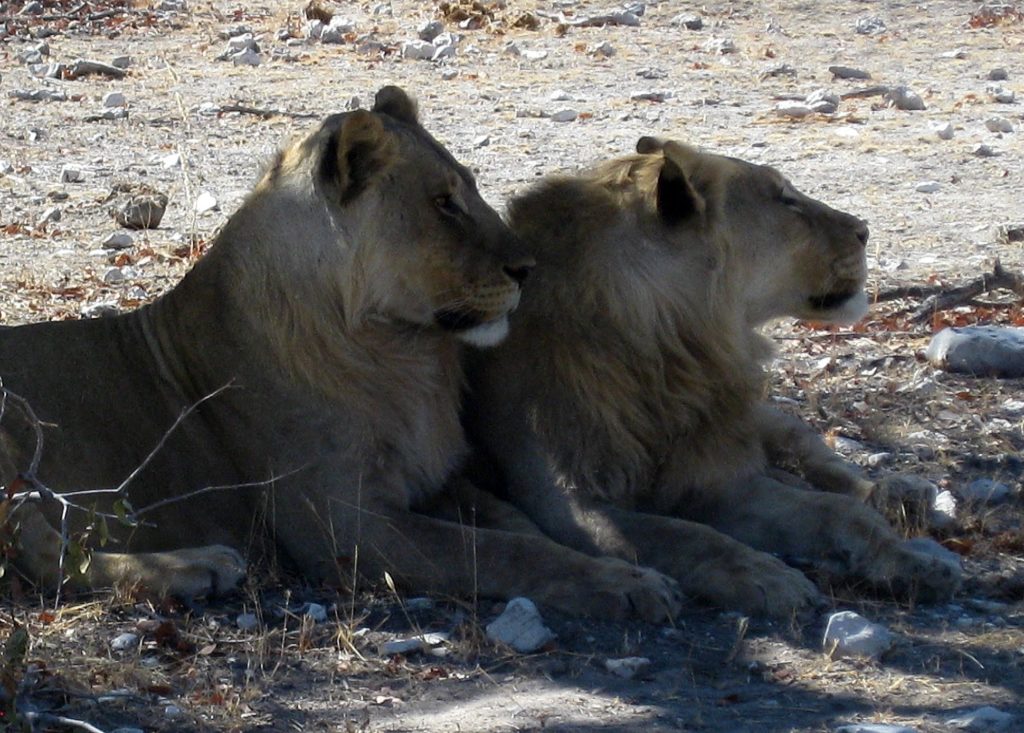
My childhood dream was no longer a dream as I drank in the sight of these amazingly beautifully strong and graceful felines in the wild. Somehow looking a lot bigger than I’d ever imagined. How many times can one say “wow”?
If life can be streamed into high-lights, then this had to be one of them. Infact the whole trip to Etosha was one big, lifes highlight.
Nature is, As Nature Does
That night we took rugs, a bottle of wine and all the warm clothes we possessed to the watering hole. Nature is, as nature does however and this night nature wasn’t doing much at all. One rhino and some hyenas were all we were lucky enough to see that night.
The next day we packed up the tent and headed via a few watering holes before pitching up again at the Okaukuejo Camp. We’d been told that there wasn’t much to see on this west side of the park. But we decided to check it out anyway. It was very barren for quite some distance but we pushed on and ended up at a very active watering hole, at the best time of the day. We just sat and watched for about an hour in the quiet. Just watching and listening to life going on as only it can at an African watering hole. A lovely way to finish our last day at the park.
We got back 10 minutes after they say the gate is locked and sure enough it really was locked. Noone answered our pleas to let us in but luckily a park’s ute arrived and told us to follow him to the left of the gates and round into the camp – phew!
This camp is more popular and therefore more populated by what seemed like loads of families with lots of noisy kids. Because of this the watering hole that night was disappointing. If I was the animals I’d avoid coming to this noisy fairground too.
The next morning on leaving the Park we stopped at one of the watering holes to the right as you’re heading back to Andersons Gate. It was another nice way to say goodbye to this beautiful place and to the animals. Once again we were lucky to be there at the right time as loads of zebras and elephants graced us with their beautiful presence.
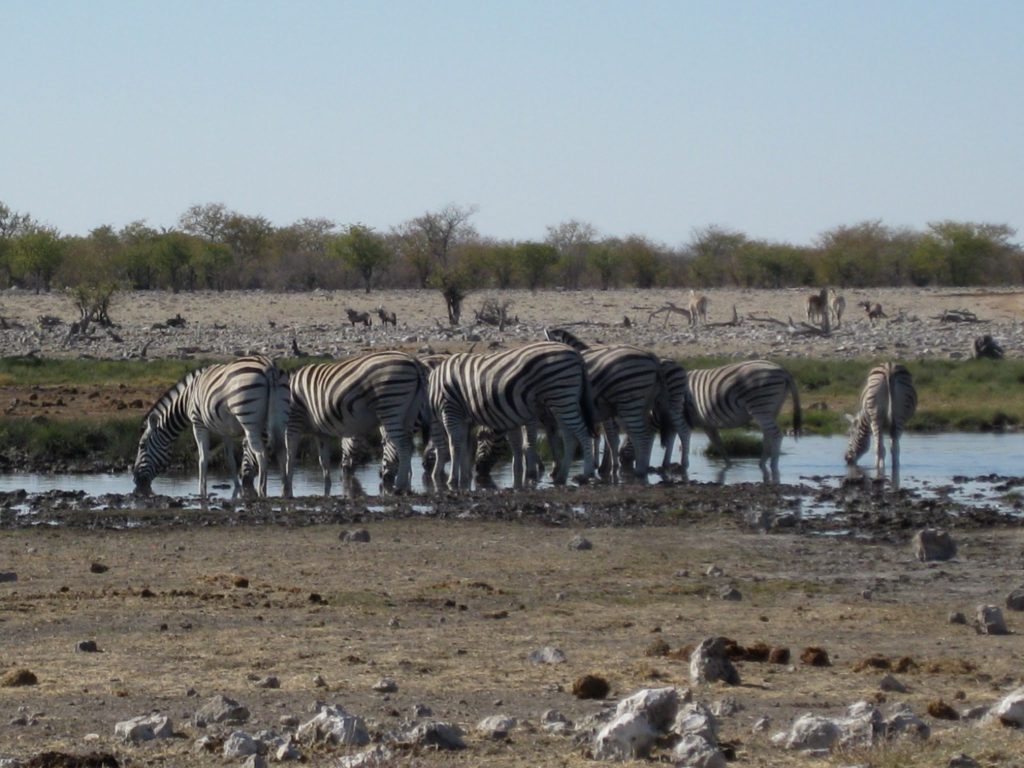
We went back through Outjo and ended up having breakfast next to the gem store because the bakery was shut. They had zebra steak on the specials menu so I gave it a go and it was a deliciously, melt in the mouth experience. I also took a slice of Mississippi Mud Cake to go.
 6.Waterberg Plateau
6.Waterberg Plateau
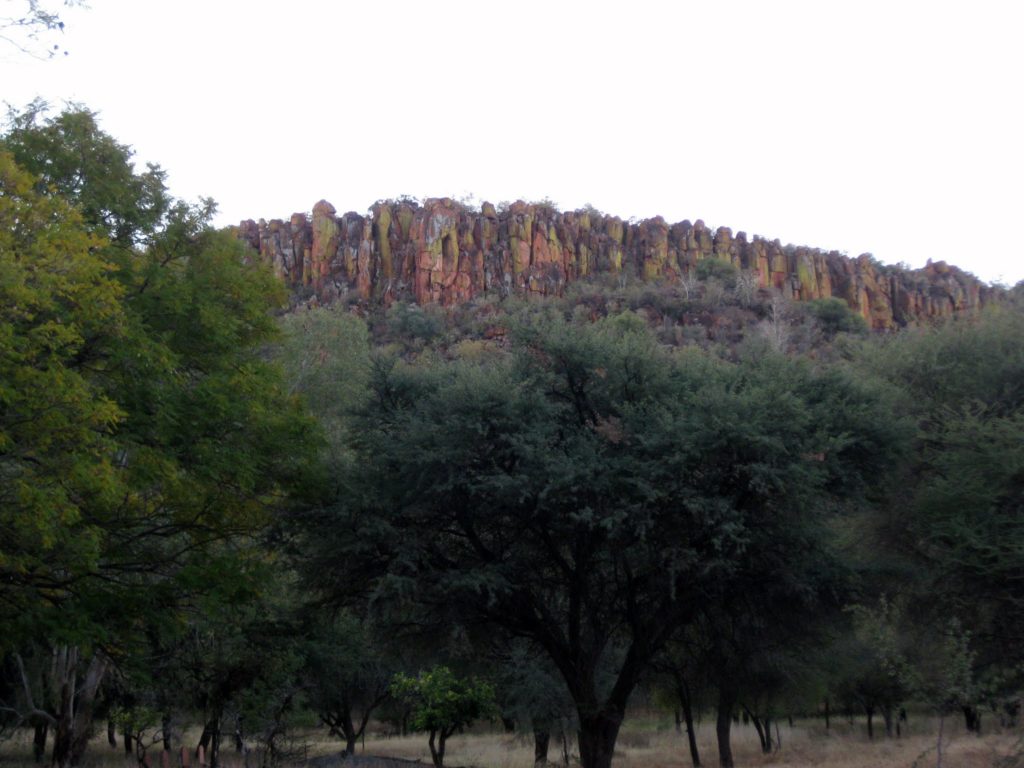 Getting There
Getting There
The Waterberg Plateau is about 288km on the C38 hours south of Etosha. Part of that is a 45 min drive on a dirt road to the actual camp site. It’s a beautiful, green spot with great places to hike, a pool to swim in and Rhino drives to go on if you chose. It would be a nice spot to spend a couple of days if you have some available, which unfortunately we didn’t. The car had to go back.
Accommodation
The camp sites are $170 na ($11.30 usd) p/p, p/night total cost. They provide lots of firewood for free and have a very impressive cooking site at each spot. Including the braai grill, they also have something like a wok/skittle and there is also another fire pit set up on the other side of the cooking area. Another awesome feature of this campsite is the wooden table with seats. We had to sit on the ground at every other campsite.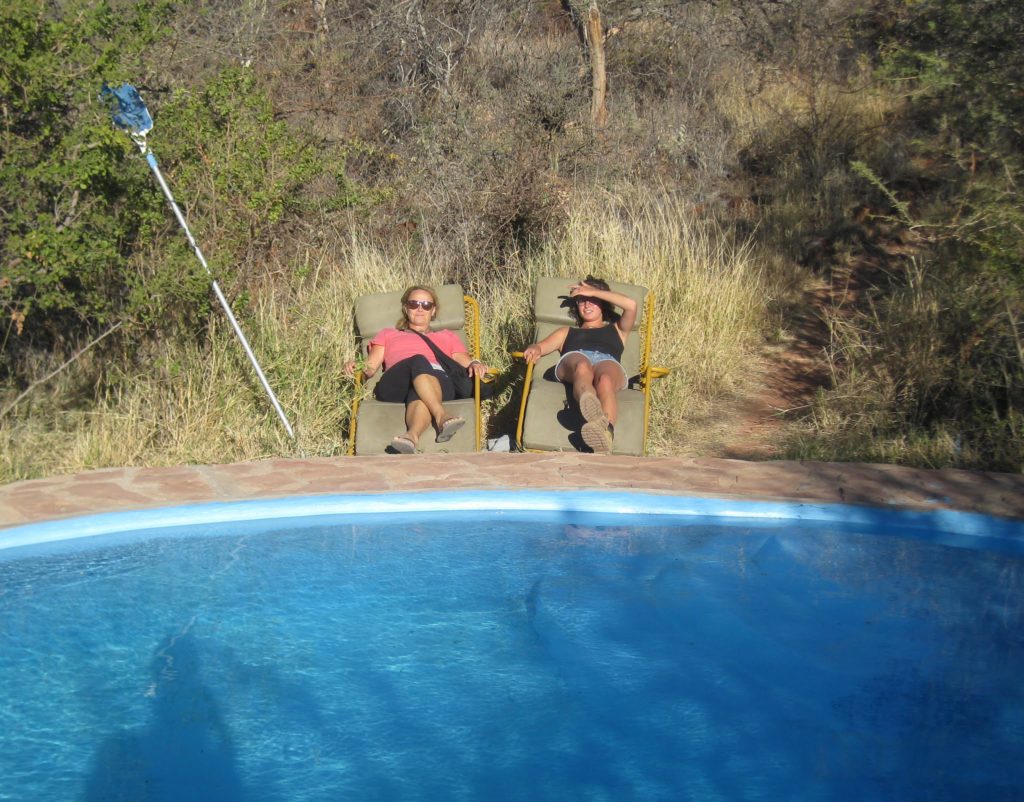
Last Stretch Of Road back to Windhoek
On leaving the next morning we were given our last glimpse of some giraffes, a group of about six of them standing near the road. I gave a local guy a lift back to the C38 road where he was heading left and we were heading right, back onto the highway. We stopped at a garage and cleaned out the car of as much dust as we could. A couple of the guys that worked at the garage actually went and found a bucket to give us a hand. Thrifty will charge you to clean the car if it’s too dirty and they will also charge you for any damage to the undercarriage, hence the slow driving on gravel road.
There was a lot of road works on the last stretch of road to Windhoek but it still only took about an hour to reach the outskirts.


Leave a Reply